
Original Link: https://www.anandtech.com/show/2208
Scythe Ninja Plus Rev. B: Updated Cooling Legend
by Wesley Fink on April 11, 2007 2:00 AM EST- Posted in
- Cases/Cooling/PSUs
In the past the Ninja name was used to designate the top-of-the-line Scythe coolers. Then somewhere along the development road the Infinity name rose to the top of the Scythe catalog. In the current Scythe lineup the two coolers are remarkably similar in features, but with slightly different design approaches to the cooling task.
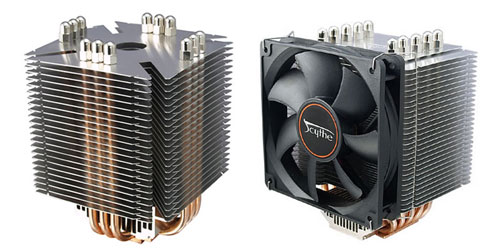
While both the Ninja and Infinity use 6 heatpipes for cooling in a tower arrangement, the Infinity is wider than it is thick and groups the heatpipes on the two sides of the fin array. The Ninja, on the other hand, is square with three in-line heatpipes on each side of the square. One purpose of this review is to determine which of these design approaches is the most effective in cooling.
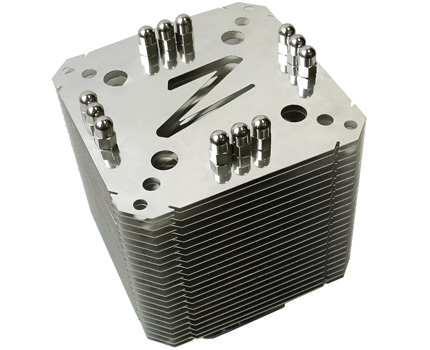
It was also pointed out in our recent review of the OCZ Vindicator that the Vindicator looked like a relabeled Ninja Plus Rev. B. Looks, however, can be very deceiving and benchmarking the Ninja Plus B should provide better answers to the question of how similar the OCZ Vindicator and Ninja Plus B actually are. If the Ninja Plus B performs much better or much worse than the Vindicator tested with the same fan, then it is reasonable to assume the designs are really different. If performance is virtually the same, then it is reasonable to conclude that these are likely the same base cooler.
There is no getting around the fact that the Scythe Ninja Plus B is a big cooler. Most of the heatpipe towers are huge, which is part of why they are effective. The good news is the fin array is raised enough that it clears the power transistor passive coolers, heatpipes, caps, and fans on every board we had in the lab. This even includes fitting on the ASUS Striker and Commando boards, which can be a challenge with their raised heatpipes and passive cooling sinks surrounding the CPU socket. There's not any room left on these ASUS boards to fit hands between the heatpipe ring of the board and the fin array of the Ninja Plus B, but you can mount and unmount the Ninja Plus B if you are careful and first remove the motherboard from the case.
Scythe Ninja Plus Rev. B
The Ninja Plus B, like the Infinity, is packaged in a very tall window box that allows the buyer to see the heatpipe tower inside.
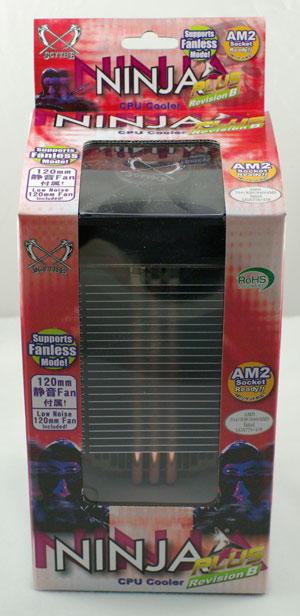
Most of the important questions are answered on the package. Included on the typical jam-packed Scythe package are specifications, pictures and a list of compatible sockets, warranty info, and details on of the included 120mm low-noise fan.

Ninja Plus B uses a different heatpipe configuration than coolers we have seen recently. Instead of staggering heatpipes, it uses six u-shaped heatpipes that are arranged three in a row on each side of the Ninja Plus B cube. This arrangement seems somewhat arbitrary as opposed to the Thermalright Ultra 120 and 120 Extreme which seem to have carefully staggered heatpipes for maximum cooling.
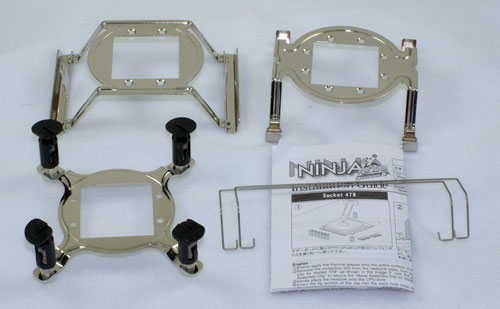
There are no mounts installed on the shipping Ninja Plus B, but the kit includes adapters for Intel 775, AMD 754/939/940/AM2, and Intel 478. Attaching the mount is very easy: just screw it onto the bottom with the four included screws and you are ready to install the heat sink. You are not required to remove the motherboard for any of the three adapters, which many users will be glad to hear. Also included is a small packet of very average white thermal paste, a pair of fan mounting wires, and a clear set of installation instructions.
Big coolers like the Ninja Plus B are a real pain to install on a motherboard mounted in a case. There just doesn't seem to be enough room between the bottom of the fin cage and the top of the push pins on the socket 775 adapter mounting to an attached motherboard. The easiest way is to remove the motherboard - particularly on socket 775 which is one of the tightest of the mounts.
If you insist on not removing the motherboard, then it is best to install the heatsink before adding the 120mm fan. This is not easy, but it is still easier to clip the fan and connect power to the fan after the heatsink install than to try to install the heatsink tower on an installed board with the fan attached.
It should also be mentioned that the fan overhangs the first DIMM socket on most boards we looked at. This is not a problem with a normal DIMM as there is enough overhang clearance for the mounted dimm. However, recent top-line DIMMs like the Corsair Dominator and OCZ Flex XLC will need to be mounted on the outer pair of dual channel slots if you want to use them with the Ninja Plus B.
Installation is pretty easy with the Ninja Plus B, but the pin connections used for Intel 775 are a concern. We had to mount a couple of times to make sure the pins were snapping into place and providing good cooler contact with the CPU surface. As with all the socket 775 push-pin connections if all pins are not fully engaged you can get less than ideal cooling.
There is also the issue of a big cooler in the typical tower case. The Ninja Plus B is a bit lighter than other big towers, but it is still a lot of weight to hang from a motherboard, with the weight supported by only 4 push-pins. It is easy to overstress the motherboard, and moving the system with the cooler attached is not recommended. In this case we would gladly give up an easy connection for a much more secure install with a reinforcing backplate.
Specifications
The Ninja Plus B will mount on all current CPU sockets, and it also supports the older Intel socket 468.
| Scythe Ninja Plus Rev. B Specifications | |
| Heatsink | |
| Dimensions | 110(L) X 110(W) X 150(H)mm (excluding fan) |
| Weight | 640g (excluding fan) |
| Material | Copper and Aluminum |
| Fan Configuration | Supports 120mm fans (120mm fan included) Open or closed mounting posts |
| Included Fan | |
| Fan Size | 120mm x 120mm x 25mm |
| Bearing Type | Sleeve Bearing |
| Noise Level | 20.94 dB-A |
| Speed | 1200 rpm |
| Air Flow | 49.6 CFM |
| Weight | 130g (fan only) |
The fan included with the Ninja Plus B seems a balance between cooling efficiency and silence. The airflow is moderate and noise is rated at 20.9 dB-A. However, the fan mount will handle any 120mm fan, so you can choose from a wide variety of popular 120mm fans if the stock fan does not deliver what you are looking for.
Ninja Plus B, like the Scythe Infinity and OCZ Vindicator, also allows mounting of multiple fans if you choose, as we demonstrated in the Scythe Infinity review. The aluminum cooling fins have a pair of grooves on each side to provide flexibility in fan mounting. Using extra wires and careful positioning you should be able to mount as many as 4 fans for cooling on the heatpipe tower. You can purchase extra fan mounting wires at the Scythe website for $1.90 US for each pair of fan wires.
CPU Cooling Test Configuration
The standard test bed for cooling tests uses an EVGA NVIDIA 680i SLI motherboard. This is primarily based on the consistent test results on this board and the excellent NVIDIA Monitor temperature measurement utility, which is part of the nTune program. The 680i chipset is also one of the better options for Socket 775 CPU overclocking, and it provides great flexibility in our standard cooler tests which overclock to the failure limit with each cooler tested.

NVIDIA Monitor has a drop-down pane for temperature measurement which reports CPU, System, and GPU results. Reviews at this point will concentrate primarily on CPU temperature. In addition to the real-time temperature measurement, NVIDIA Monitor also has a logging feature which can record temperature to a file in standard increments (we selected every 4 seconds). This allows recording of temperatures during testing and play back, for example, of stress test results that can then be examined when the stress tests are completed. There is also the handy reference of speeds and voltages in the top pane to confirm the test setup.
Other components in the cooling test bed are generally the same as those used in our motherboard and memory test bed:
| Cooling Performance Test Configuration | |
| Processor | Intel Core 2 Duo X6800 (x2, 2.93GHz, 4MB Unified Cache) |
| RAM | 2x1GB Corsair Dominator PC2-8888 (DDR2-1111) |
| Hard Drive(s) | Hitachi 250GB SATA2 enabled (16MB Buffer) |
| Video Card: | 1 x EVGA 7900GTX - All Standard Tests |
| Platform Drivers: | NVIDIA 9.53 |
| NVIDIA nTune: | 5.05.22.00 (1/16/2007) |
| Video Drivers: | NVIDIA 93.71 |
| CPU Cooling: | Scythe Ninja Plus Rev. B OCZ Vindicator Thermalright Ultra 120 Extreme Thermalright Ultra 120 Scythe Infinity Zalman CNS9700 Zalman CNS9500 Cooler Master Hyper 6+ Vigor Monsoon II Lite Thermalright MST-9775 Scythe Katana Tuniq Tower 120 Intel Stock HSF for X6800 |
| Power Supply: | OCZ PowerStream 520W |
| Motherboards: | EVGA nForce 680i SLI (NVIDIA 680i) |
| Operating System(s): | Windows XP Professional SP2 |
| BIOS | Award P24 (1/12/2007) |
All cooling tests are run with the components mounted in a standard mid-tower case. The idle and stress temperature tests are run with the case closed and standing as it would in most home setups. We do not use auxiliary fans in the test cooling case, except for the north bridge fan attached to the 680i for overclocking.
Since Scythe provides a small packet of a standard white thermal compound, we tested with a premium silver colored (no silver content) thermal compound we have used in testing coolers that did not include a proprietary thermal compound in the cooler kit.
In our experience the thermal compound used makes little to no difference in cooling test results. This is particularly true now that processors ship with a large manufacturer-installed heatspreader. Our only control on thermal compound is that we use the manufacturer-supplied product if they supply a premium product, or a standard high-quality thermal paste if a premium brand is not supplied.
We first tested the stock Intel cooler at standard X6800 speed, measuring the CPU temperature at idle and while the CPU was being stressed. We stressed the CPU by running continuous loops of the Far Cry River demo. The same tests were repeated at the highest stable overclock we could achieve with the stock cooler. Stable in this case meant the ability to handle our Far Cry looping for at least 30 minutes.
The same tests were then run on the cooler under test at stock, highest stock cooler OC speed (3.73GHz), and the highest OC that could be achieved in the same setup with the cooler being tested. This allows measurement of the cooling efficiency of the test unit compared to stock and the improvement in overclocking capabilities, if any, from using the test cooler.
Noise Levels
In addition to cooling efficiency and overclocking abilities, users shopping for CPU cooling solutions may also be interested in the noise levels of the cooling devices they are considering. Noise levels are measured with the case open on its side and are measured using a C.E.M. DT-8850 Sound Level meter. This meter allows accurate sound level measurements from 35bdB to 130dB with a resolution of 0.1dB and an accuracy of 1.5dB. This is sufficient for our needs in these tests, as measurement starts at the level of a relatively quiet room. Our own test room, with all computers and fans turned off, has a room noise level of 36.4dB.
Our procedures for measuring cooling system noise are described on page seven along with noise results comparing the stock Intel cooler and recently tested CPU coolers to the Scythe Ninja Plus B.
Additional Fan Tests
Initial test results showed the fan of the Scythe Ninja Plus B, while a better performer than the OCZ Vindicator fan, was still more slanted to silence than cooling performance. The stock fan provided average results in AnandTech cooler overclocking tests. To determine whether the overclocking limitations were a result of the cooler design or the fan selection, additional cooling tests were run with a new fan first used in the OCZ Vindicator review.
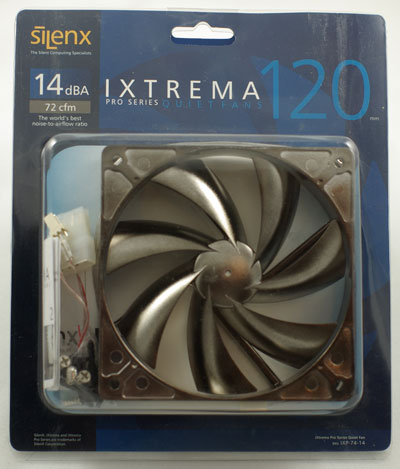
The SilenX IXTREMA 120 claims to provide the world's best noise-to-airflow ratio. The specifications claim a 14 dB-A noise level coupled with 72 CFM airflow. Perhaps even more remarkable is the rated watts of 1.92 which should be safe on almost any motherboard fan header.
The SilenX made quite a difference in the performance of the OCZ Vindicator which may be a rebadged Ninja Plus B. To determine if that was really the case we were interested in testing the Ninja Plus B with the same fan to see if results were the same. This will help answer the question as to whether the two coolers merely look similar or are in fact the same cooler with a different name. Results with a single stock fan and a single SilenX IXTREMA 120 are reported in all performance charts and graphs for the OCZ Vindicator and the Scythe Ninja Plus B.
We extend our sincere thanks to Frozen CPU for providing the SilenX IXTREMA 120 for testing. We are preparing for a roundup of 120 fans and Frozen CPU has provided an assortment of new and innovative fans that we think you will enjoy seeing in the upcoming 120 fan roundup.
Push-Pull Testing
Since a push-pull fan configuration made a significant improvement in our review of the Scythe Infinity cooler, push-pull was briefly tested using two stock Scythe Ninja Plus B fans. Overclocking performance was also tested briefly using two SilenX IXTREMA 120 fans.
Push-Pull results were similar to the findings on the Infinity. A single stock Scythe fan topped out at an overclock of 3.83Ghz. Using two of the 49.6 CFM fans allowed us to reach a top stable overclock of 3.9GHz, matching the top heatpipe tower coolers and the push-pull Infinity.
However, a single 72 CFM SilenX also allowed a top stable overclock of 3.90GHz, matching the top results with the Thermalright Ultra 120/SFLEX, Tuniq Tower 120, OCZ Vindicator (with SilenX fan), and Scythe Infinity (with two push/pull 46.5 CFM fans). This certainly points to a better fan providing better results with the Ninja Plus B. The soon-to-be-released Thermalright Ultra 120 Extreme remains alone at the top of our performance charts with an overclock of 3.94GHz combined with temperatures among the lowest tested at each overclock.
With these results with a single SilenX we tried two SilenX 72 CFM fans in a push-pull configuration on the Ninja Plus B . This configuration provided no better overclocking than a single 72 CFM SilenX, but cooling was 2C better at the highest overclock of 3.9GHz. The Single SilenX was 42C idle and 62C load at 3.9GHz, where the two SilenX measured 40C at idle and 60C at load.
We can surmise from these results that airflow in the 72 CFM to 100 CFM range is likely optimum for highest overclocking and best cooling performance with the Ninja Plus B. Of course this is also impacted by the static pressure of the fan chosen for cooling. Certainly increasing airflow in the Ninja Plus B definitely improves performance, but the increase is not without limits. Eventually you reach the point where increasing airflow provides no further improvements in overclocking or cooling. This optimum point is likely to vary with each cooler and each type of design. It is a subject we will explore further in our 120mm fan roundup.
Cooling at Stock Speed
Some users will never overclock their CPU, but they still want to run the coolest CPU temperatures possible to enhance stability and extend CPU life. The Scythe Ninja Plus B kit includes a moderate output low noise 120mm fan. We also tested the Vindicator with the 120mm SilenX IXTREMA 120 fan.
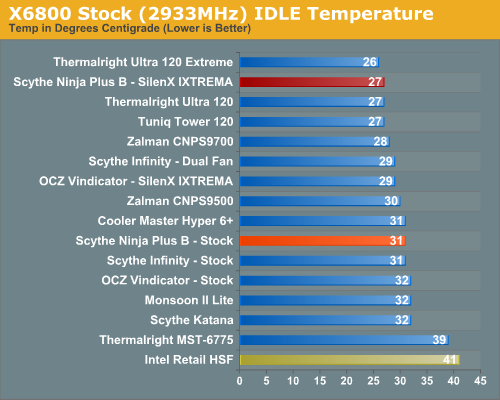
With the stock fan the end user does get relative silence, but the cost is poorer cooling than most other heatpipe towers tested at AnandTech. As soon as the switch is made to the SilenX fan you can see this cooler is starved for airflow with the stock fan. Idle temps with the SilenX drop to 27C, which is among the best measured performance at stock Idle in our cooler reviews
It is more difficult to effectively simulate a computer being stressed by all of the conditions it might be exposed to in different operating environments. For most home users CPU power is most taxed with contemporary gaming. Therefore our stress test simulates running a demanding contemporary game.
The Far Cry River demo is looped for 30 minutes and the CPU temperature is captured at 4 second intervals with the NVIDIA monitor "logging" option. The highest temperature during the stress test is then reported. Momentary spikes are ignored, as we report a sustained high-level temp that you would expect to find in this recording configuration.
Cooling efficiency of the Scythe Ninja Plus B was tested under load conditions with both the stock fan and the SilenX at stock speed. Results are compared to the Intel retail HSF and other recently tested CPU coolers.
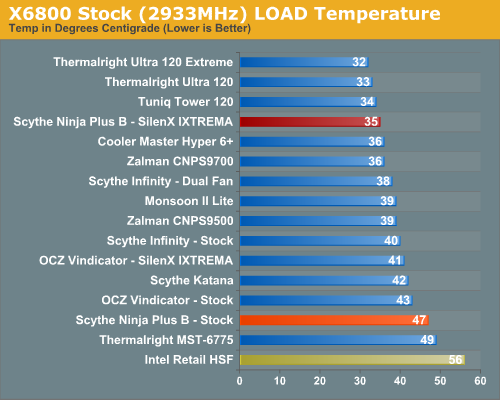
The Ninja Plus B under load at stock speeds reached a maximum temperature of 47C with the stock cooler. This was among the worst load results at stock speed with the coolers tested at AnandTech. Switching to the SilenX fan improved the load temperature to 35C. This is a stellar result, and one of the best stock speed load temperatures we have tested. This compared to the Tuniq at 34C, the Cooler Master Hyper 6+ and Zalman 9700 at 36C, the Thermalright Ultra 120 at 33C , and the top Ultra 120 Extreme at 32C.
It should also be clear that cooling results with the Scythe Ninja Plus B are quite different than results with the OCZ Vindicator using the same SilenX fan. The Ninja Plus B cools better than the Vindicator using the same fan. This strongly suggests that while the Vindicator looks similar it is not just a rebadged Scythe Ninja Rev. B. There are enough differences in their designs to have an impact on cooling performance. This becomes clearer in a closer look at cooler performance scaling.
Scaling of Cooling Performance
The Thermalright Ultra 120 Extreme has been the top performer so far in CPU cooling at stock speeds. As overclocks are raised, the Ultra 120 with the Scythe SFLEX fan maintains its cooling advantage. The Scythe Ninja Plus B is average in cooling efficiency with the stock fan. However, a swap to the specified 14 dB-A/72 CFM SilenX fan improved cooling to the levels of the top tier heatpipe towers in our reviews.

At 2.93GHz the retail HSF is running at 41C, compared to 31C with the Scythe Ninja Plus B with the stock fan.. This is a delta of 10C. The SilenX drops that temperature to 27C, or a delta of 14C. The delta with the stock fan remains about the same as the overclock increases. At 3.73GHz the idle with the retail fan is 56C compared to the Ninja stock at 47C - a delta of 9C. Performance improvements are much greater with the SilenX fan on the Ninja Plus B. At 3.73GHZ the SilenX cools to 36C, while at the highest stable overclock of 3.90GHz the Ninja/SilenX is at 42C. This almost flat line at idle at the top of our testing is an indication the SilenX is effectively cooling at idle all the way to the top speed that could be reached in benchmarking.
Cooling efficiency of the Ninja Plus B, with stock and SilenX fans, was next tested under load conditions. Results are compared to the retail HSF and other recently tested CPU coolers. The Scythe Ninja Plus B with the SilenX fan generated results almost identical to the Scythe Infinity with Push-Pull fans and reached the upper tier of overclocking performance. Results with the stock fan were average.

By 3.90 GHz - the highest overclock the Tuniq, Thermalright Ultra 120, OCZ Vindicator, and push-pull Scythe Infinity could reach with stability - the Ninja Plus B is at 62C with the SilenX fan. This is still worse cooling performance than many of other top coolers at this speed. Push-pull SilenX fans lower this only a couple of degrees more - to 60C. The Tuniq and Ultra 120 are both at 51C, which is some 9C to 12C lower than the Ninja Plus B. However, the Scythe was completely stable at 3.90GHz with the SilenX fan even though it ran a bit warmer. The single stock fan could only manage 3.83GHz so the SilenX or dual Sythe low-noise fans in push-pull configuration are much better fan setups for overclocking the Ninja Plus B.
As stated many times, the overclocking abilities of the CPU will vary at the top, depending on the CPU. This particular CPU does higher FSB speeds than any X6800 we have tested, but the 3.9GHz top speed with the top tier heatpipe towers is pretty average among the X6800 processors we have tested with Tuniq cooling. A few of the other processors tested with the best air coolers reach just over 4 GHz, but the range has been 3.8 to 4.0GHz. Stock cooling generally tops out 200 to 400 MHz lower, depending on the CPU, on the processors tested in our lab.
Overclocking
As cooling solutions do a better job of keeping the CPU at a lower temperature, it is reasonable to expect the overclocking capabilities of the CPU will increase. In each test of a cooler we measure the highest stable overclock of a standard X6800 processor under the following conditions:
CPU Multiplier: 14x (Stock 11x)
CPU voltage: 1.5875V
FSB Voltage: 1.30V
Memory Voltage: 1.90V
nForce SPP Voltage: 1.35V
nForce MCP Voltage: 1.7V
HT nForce SPP <-> MCP:
Auto
Memory is set to Auto timings on the 680i and memory speed is linked to the FSB for the overclocking tests. This removes memory as any kind of impediment to the maximum stable overclock. Linked settings on the 680i are a 1066FSB to a memory speed of DDR2-800. As FSB is raised the linked memory speed increases in proportion. The same processor is used in all cooling tests to ensure comparable results.
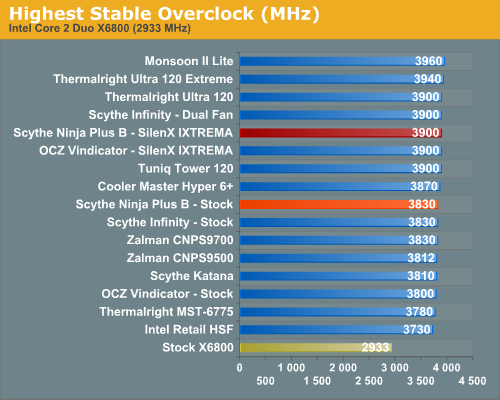
The Scythe Ninja Plus B with the stock fan could only reach 3.83GHz overclock with stability. This is a little better OC than the OCZ Vindicator with the stock fan and matches the performance of the Scythe Infinity with a single stock fan. It is not, however, performance comparable to the top tier of the heatpipe towers tested.
However a change to the 72 CFM 14 dB-A SilenX IXTREMA 120 allowed us to push the overclock to 3.90GHz with complete stability. This does match the top tier of overclocks achieved by the Tuniq Tower 120, Thermalright Ultra 120/Scythe SFLEX, OCZ Vindicator (with SilenX), and Scythe Infinity with dual push-pull fans.
The only air cooler that has reached higher than 3.90GHz is the Thermalright Ultra 120 Extreme, which was featured at CeBIT. We managed 3.94GHz with that top air cooler. The hybrid TEC/air Monsoon II Lite reached 3.96GHz in benchmarking, but that cooler combines active TEC cooling with passive air cooling and would be expected to reach higher overclocks than an air alone solution.
Noise
For many enthusiasts upgrading cooling the goal is maximum stable overclock, and they will live with the inconvenience of a louder system. For other users silence is the most important factor, and these users will forgo maximum overclocking if that increases system noise levels.
We measured noise levels with the Scythe Ninja Plus B with both stock and SilenX IXTREMA fans under both load and idle conditions. The fans have specified noise ratings of 20.9 dB-A and 14 dB-A, and the measured noise with both fans was below our system noise floor at both 6" and 24" positions above the open side of our system case.
There are virtually no power supplies that do not include a fan. While Zalman and a few others do make an expensive fanless power supplies, we have not seen a fanless unit larger than 500W, or one that would be used for seriously overclocking a system. With that in mind the noise level of the system with all fans turned off except the power supply was measured. The power supply used for the cooling test bed was the OCZ PowerStream 520, which is one of the quieter of the high performance power supplies.
We have also measured the Corsair 620-watt and Mushkin 650-watt power supplies which are reported to be quieter than the OCZ. Both the Corsair and Mushkin are indeed quieter at idle or start up speed. However, as soon as load testing begins and the PSU fan speed kicks up the measured noise level is almost exactly the same as the OCZ PowerStream 520 watt power supply.
We are currently in the process of evaluating "quieter" power supplies for an update to our cooler test bed. We will make changes to that test bed as soon as we are confident in the noise measurements and test procedures with a variable speed quiet PSU. We plan to evaluate additional power supplies and configurations in our upcoming 120mm fan roundup, at which point we will complete the transition to a revised and lower noise cooler test bed.
The noise level of the power supply was 38.3 dB from 24" (61cm) and 47 dB from 6" (152mm). The measured noise level of the test room is 36.4 dB, which would be considered a relatively quiet room with a noise floor slightly below the OCZ PowerStream 520 PSU.
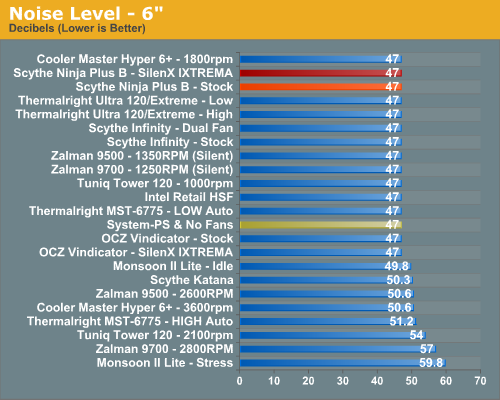
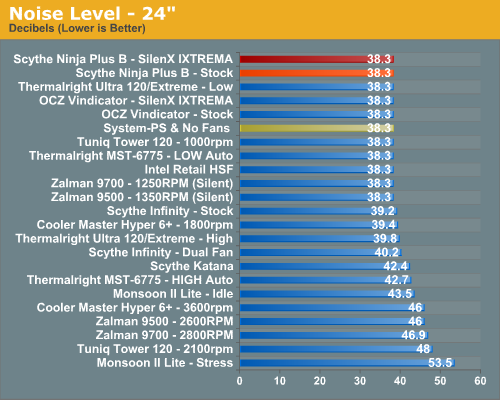
Measured noise levels in this chart should be considered worst case. Measurements were taken with an open side of a mid tower case 6" and 24" from the HSF. Real world would be a completely closed case resulting in a further reduction in noise.
Any 120mm fan that is a standard 25mm thick should be mountable on the Scythe Ninja Plus B. The fan clips connect to the outside mount hole, which means both open post and the more common closed post fans will work properly. The stock Ninja fan is closed post and the SilenX is open post. This means the SilenX will work on any cooler we have reviewed thus far - including the Thermalright Ultra 120 and Ultra 120 Extreme.
Final Words
Scythe's Ninja Plus Revision B is an update to a long-running and well-regarded heatpipe tower cooler. The design mounts six u-shaped heatpipes in three heatpipe clusters on each side of a square fin tower. The fin tower has slots for mounting clips on each side, which means up to 4 cooling fans can be mounted. The kit ships with one low-noise 120mm fan of moderate 49.6 CFM output.
The Ninja Plus B comes with easy to install mounts for Intel socket 775, AMD AM2/939/940/754 and the older Intel socket 478. The 775 mount uses push clips for mounting just like the Intel stock design, but this also brings concerns about a large, heavy cooler being mounted with such a flimsy connector, which was clearly intended for lighter weight coolers. We have had no problems with stressing the motherboard or falling coolers in vertical towers, but we strongly recommend that this is not a mount design for a LAN Party PC that will be moved frequently.
With the stock low-noise fan the performance of the Ninja was about the same as the Scythe Infinity - average but not chart-topping - with a maximum OC of 3.83GHz. However, like the Infinity, the Ninja has very flexible options for mounting 1-4 fans and performance with two standard Scythe fans in a push-pull arrangement reached 3.90GHz. This places the Ninja in the top tier of coolers we have tested.
The Ninja Pus B also managed to reach a 3.90GHz stable overclock with a single, higher output SilenX fan specified as 72 CFM/14 dB-A. Cooling performance and overclocking with the single SilenX fan were virtually the same as results with a dual fan push-pull using two of the low noise Scythe fans. With both the Scythe and SilenX fans cooling the Ninja Plus B noise levels remained below the noise floor of the system.
Cooling and overclocking tests were also run with two 72 CFM SilenX fans in a push pull arrangement on the Ninja Plus B. The highest stable overclock with this combo remained at 3.90GHz - there was no improvement in overclocking ability. However, two SilenX fans in push-pull cooled about 2C better at idle and load than a single SilenX fan or two Scythe fans in push-pull configuration.
As packaged the Scythe Ninja Plus B is a competent and quiet cooler. The Scythe kit is a more effective cooler than the similar OCZ Vindicator, but neither kit is chart topping. Swap the stock fan with a SilenX 72 CFM/14 dB-A fan, however, and the Ninja Plus B is then able to overclock to 3.90GHz, matching the best heatpipe towers we have tested. Comparing results of the Scythe Ninja Plus B with the SilenX to the OCZ Vindicator with the same fan proves rather conclusively that the OCZ Vindicator is not just a relabeled Ninja Plus B. The Scythe cooler does a better job of cooling with the same fan, and while the coolers may look the same, the Ninja is definitely the more effective cooler.
With results of the Scythe infinity and Scythe Ninja Plus B so similar in our tests, it is fair to ask which cooler is the better choice. That is a hard question to answer, but the Infinity is a little more compact in most cases and cools just as well as the large square Ninja. The choice depends on your preferences and the board/case that will be used with the cooler. However, both the Ninja Plus B and the Infinity are just good, quiet coolers with the shipping kit fans - they are not particularly great for overclocking. Add a quiet high output fan like the SilenX or use two Scythe fans in a push-pull configuration, and both coolers compete with the best we have tested. The Tuniq Tower 120 and Thermalright Ultra 120 still cool a bit better at most settings, but they reach the same overclock as the Ninja and Infinity with push-pull fans or a SilenX.
The Thermalright Ultra 120 Extreme remains the best air cooler we have tested so far, reaching a 3.94GHz overclock at low temperatures with a Scythe SFLEX fan. The Scythe Ninja Plus B joins the top tier of coolers just below this with the Thermalright Ultra 120, Tuniq Tower 120, OCZ Vindicator with SilenX fan, and Scythe Infinity push-pull. In any of the tested configurations it is a quiet and effective cooler, with best cooling results with a high output fan or push-pull fans.







